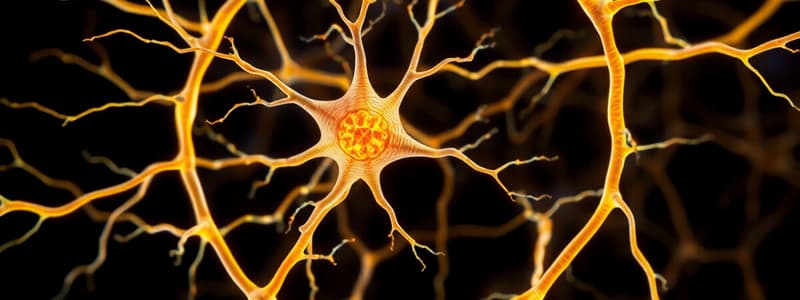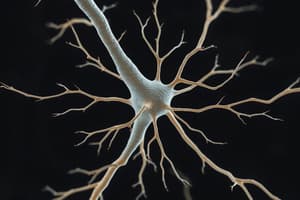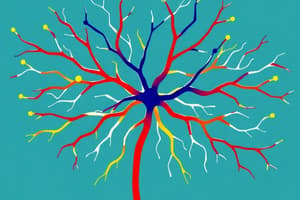Podcast
Questions and Answers
A person touches a hot stove and quickly pulls their hand away. Which of the following accurately describes the pathway of this reflex arc?
A person touches a hot stove and quickly pulls their hand away. Which of the following accurately describes the pathway of this reflex arc?
- Sensory neuron -> Spinal cord -> Brain -> Motor neuron -> Muscle
- Sensory neuron -> Brain -> Spinal cord -> Motor neuron -> Muscle
- Sensory neuron -> Spinal cord -> Motor neuron -> Muscle (correct)
- Sensory neuron -> Brain -> Motor neuron -> Muscle
During the resting state of a neuron, the inside of the cell is positively charged relative to the outside.
During the resting state of a neuron, the inside of the cell is positively charged relative to the outside.
False (B)
What are the two primary types of hearing loss, and what general parts of the ear are affected by each?
What are the two primary types of hearing loss, and what general parts of the ear are affected by each?
Conductive hearing loss affects the outer or middle ear, while sensorineural hearing loss affects the inner ear or auditory nerve.
__________ neurons carry information from the sensory receptors to the central nervous system, while __________ neurons carry information from the central nervous system to the muscles and glands.
__________ neurons carry information from the sensory receptors to the central nervous system, while __________ neurons carry information from the central nervous system to the muscles and glands.
Match each lobe of the brain with its primary function:
Match each lobe of the brain with its primary function:
Flashcards
What are Dendrites?
What are Dendrites?
Receives signals from other neurons.
What is the Myelin Sheath?
What is the Myelin Sheath?
A fatty substance that insulates axons, speeding up signal transmission.
What is a Synapse?
What is a Synapse?
The gap between two neurons where neurotransmitters are released and received.
What are Afferent Neurons?
What are Afferent Neurons?
Signup and view all the flashcards
What is a Reflex?
What is a Reflex?
Signup and view all the flashcards
Study Notes
- The nervous system's functions include sensory input, integration, control of muscles and glands, homeostasis, and mental activity.
Central Nervous System
- The central nervous system consists of the brain and spinal cord.
Peripheral Nervous System
- The peripheral nervous system includes all nerve tissue outside the brain and spinal cord.
Types of Neurons
- Afferent (sensory) neurons
- Efferent (motor) neurons
- Interneurons (association neurons)
Afferent Neurons
- Afferent neurons transmit sensory information from receptors to the central nervous system.
Efferent Neurons
- Efferent neurons transmit motor commands from the central nervous system to effectors (muscles/glands).
Neuron Structure
- Dendrites receive signals from other neurons.
- The Soma (cell body) contains the nucleus and integrates signals.
- The Axon transmits signals away from the soma.
- The Myelin Sheath insulates the axon, speeding up signal transmission.
- Nodes of Ranvier are gaps in the myelin sheath that allow for rapid conduction.
- Axon Terminals are the ends of the axon that transmit signals to other neurons or cells.
- The Synapse is the junction between two neurons where signals are transmitted.
- Neurotransmitters are chemicals that transmit signals across the synapse.
Neuron Resting State
- During its resting state, a neuron has a negative charge inside compared to the outside, called the resting membrane potential.
- Maintained by ion pumps and differential permeability to ions.
Action Potential Steps
- Depolarization occurs when the membrane potential becomes more positive due to influx of sodium ions.
- Threshold is the level of depolarization required to trigger an action potential.
- Repolarization occurs as potassium ions flow out, restoring the negative membrane potential.
- Hyperpolarization is a brief period where the membrane potential is more negative than the resting state.
Reflex vs. Voluntary Motion
- A reflex is an involuntary, automatic response to a stimulus.
- Voluntary motion is a conscious, controlled movement.
Pathways
- The pathway for voluntary motion involves the brain making a decision, which then sends a signal down the spinal cord to motor neurons, which then activate muscles.
- Reflex pathways involve sensory neurons sending signals to the spinal cord, which then directly activate motor neurons bypassing the brain.
Brain Lobe Functions
- The Frontal Lobe controls higher-level cognitive functions like reasoning, planning, and motor control.
- The Parietal Lobe processes sensory information like touch, temperature, and pain.
- The Temporal Lobe is responsible for auditory processing, memory, and language comprehension.
- The Occipital Lobe is responsible for visual processing.
- The Cerebellum coordinates movement and balance.
- The Brain Stem controls basic life functions like breathing and heart rate.
Autonomic Functions
- An example of an autonomic function is heart rate.
- The brain stem controls autonomic functions.
CNS Protection
- The layers of protection for the central nervous system include the skull/vertebrae, meninges (dura mater, arachnoid mater, pia mater), and cerebrospinal fluid.
Concussion
- A commotion is a traumatic brain injury that affects brain function.
Eye Structure
- The Cornea is the transparent outer layer that focuses light.
- The Pupil is the opening that controls the amount of light entering the eye.
- The Iris is the colored part of the eye that adjusts the size of the pupil.
- The Lens focuses light onto the retina.
- The Vitreous Humor is the gel-like substance that fills the space between the lens and retina.
- The Retina contains photoreceptors that detect light and convert it into electrical signals.
- The Optic Nerve transmits signals from the retina to the brain.
- The Sclera is the white outer layer of the eye that provides protection.
20/20 Vision
- 20/20 vision means that at 20 feet, you can see what a person with normal vision can see at 20 feet.
- 20/15 vision is better (you can see at 20 feet what a normal person sees at 15 feet).
- 20/30 vision is worse (you can see at 20 feet what a normal person sees at 30 feet).
Depth Perception
- Depth perception is the ability to judge the distance of objects.
- Achieved through binocular cues (using both eyes) and monocular cues (using one eye).
Hearing Loss
- Conductive hearing loss is caused by problems with the outer or middle ear that prevent sound from reaching the inner ear.
- Sensorineural hearing loss is caused by damage to the inner ear or auditory nerve.
- Conductive hearing loss affects the outer and middle ear parts.
- Sensorineural hearing loss affects the inner ear parts.
Ear Structure
- The Pinna (auricle) collects sound waves.
- The Auditory Canal transmits sound waves to the tympanic membrane.
- The Tympanic Membrane (eardrum) vibrates in response to sound waves.
- The Auditory Ossicles (malleus, incus, stapes) amplify and transmit vibrations to the oval window.
- The Cochlea converts vibrations into electrical signals.
- The Auditory Nerve transmits signals from the cochlea to the brain.
Studying That Suits You
Use AI to generate personalized quizzes and flashcards to suit your learning preferences.




